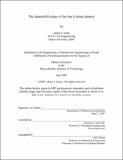The industrial ecology of the iron casting industry
Author(s)
Jones, Alissa J. (Alissa Jean)
DownloadFull printable version (1.879Mb)
Other Contributors
Massachusetts Institute of Technology. Dept. of Mechanical Engineering.
Advisor
Timothy G. Gutowski.
Terms of use
Metadata
Show full item recordAbstract
Metal casting is an energy and materials intensive manufacturing process, which is an important U.S. industry. This study analyzes iron casting, in particular, for possible improvements that will result in greater efficiencies and therefore greater global competitiveness. The quantity and types of materials and energy used are dependent on the technologies selected and the cast part parameters. The most energy intensive step is melting, which is explored with an input-output analysis and an energy comparison of three major technologies: cupola melting and the heel and batch types of coreless electric induction melting. The major goal of this project is the creation of a material and energy flow model of the typical iron casting facility. This input-output process model is used to analyze the effect that different melting technologies will have on energy, materials and pollution, including selected upstream processes. Findings show that energy and the associated carbon dioxide emissions vary widely with melting technology and the relative benefits depend on where the boundaries are drawn in the analysis. (cont.) An understanding of the current technology then allows for the analysis of new technologies under development and how they will affect the facility in terms of material and energy use, pollution and economics. The model is based on data collected from partner casting companies. The study concludes with a review of the available policy options which can improve the environmental profile of the facilities.
Description
Thesis (S.M.)--Massachusetts Institute of Technology, Dept. of Mechanical Engineering, 2007. This electronic version was submitted by the student author. The certified thesis is available in the Institute Archives and Special Collections. Includes bibliographical references.
Date issued
2007Department
Massachusetts Institute of Technology. Department of Mechanical EngineeringPublisher
Massachusetts Institute of Technology
Keywords
Mechanical Engineering.